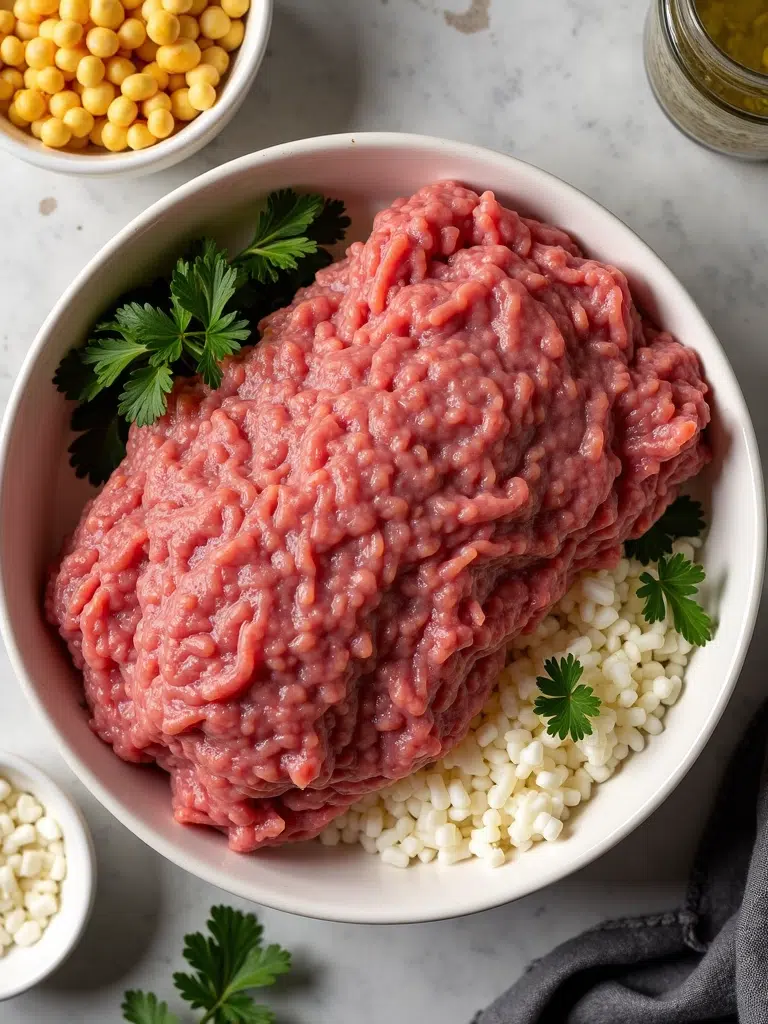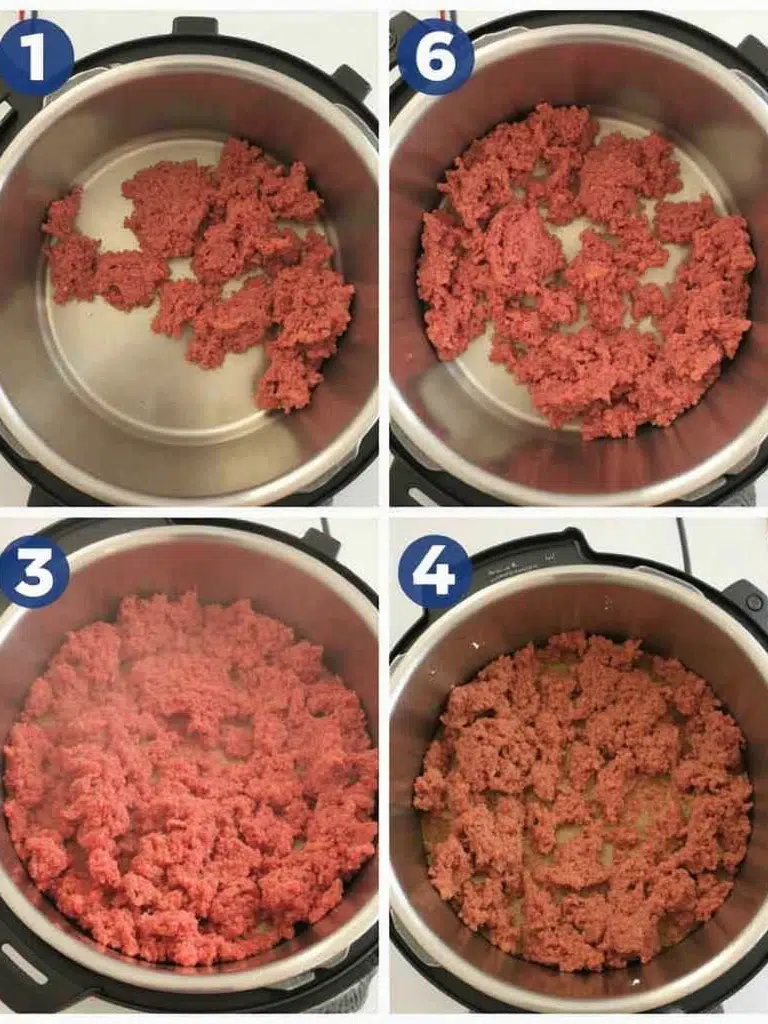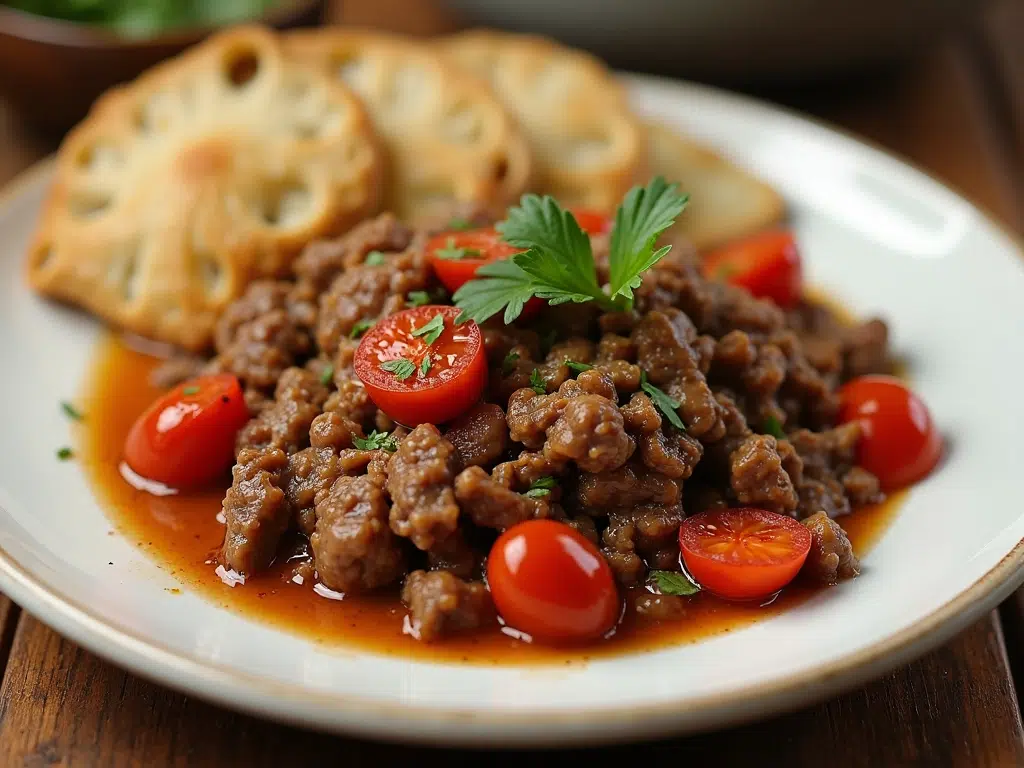Introduction
Learning how to cook ground beef properly transforms this everyday ingredient into something extraordinary. Whether you’re making tacos, pasta sauce, or classic burgers, mastering the technique for perfectly browned, juicy ground beef elevates every dish. I’ve spent years perfecting methods that bring out the rich flavors while maintaining ideal texture—and I’m excited to share these game-changing techniques with you today.
Looking for inspiration after mastering the basics? Check out my collection of delicious ground beef recipes that showcase this versatile protein in creative ways!
Table of Contents
Ingredients You Will Need

To perfectly cook ground beef, you’ll need these simple but essential ingredients:
- 1 pound ground beef (80/20 lean-to-fat ratio recommended for best flavor)
- 1 tablespoon high-heat cooking oil (canola, vegetable, or avocado oil)
- 1/2 teaspoon salt (kosher salt works best)
- 1/4 teaspoon freshly ground black pepper
- Optional aromatics: 1 small diced onion, 2 minced garlic cloves
- Optional seasonings: paprika, cumin, chili powder, or Italian seasoning
The 80/20 ratio delivers the ideal balance of flavor and juiciness. For leaner options, 85/15 or 90/10 work well but may require additional moisture from onions or tomato paste. Grass-fed beef offers a richer, more complex flavor profile with added nutritional benefits if you’re looking to elevate your dish even further.
Timing
Proper timing is crucial when cooking ground beef to achieve the perfect balance of flavor and texture:
- Preparation time: 5 minutes (gathering ingredients and equipment)
- Cooking time: 8-10 minutes (30% faster than most recipes that needlessly overcook)
- Total time: 15 minutes
This quick cooking process makes ground beef an excellent option for weeknight meals. Unlike longer cooking methods that can toughen the meat, this approach ensures your beef remains juicy while developing that coveted caramelized exterior.
Step-by-Step Instructions

Step 1: Prepare Your Pan
Heat a large skillet (preferably cast iron or stainless steel) over medium-high heat. Add 1 tablespoon of oil and swirl to coat the surface. The right pan temperature is crucial—you should see light wisps of smoke indicating it’s hot enough to create that perfect sear without burning.
Insider tip: Test your pan’s readiness by flicking a few drops of water onto the surface. If they sizzle and dance, you’re good to go!
Step 2: Add the Ground Beef
Add the ground beef to the hot pan, but resist the urge to stir immediately. Let it sit untouched for about 2 minutes to develop a beautiful brown crust on the bottom. This patience pays off with enhanced flavor through the Maillard reaction—the chemical process that creates those deep, savory notes.
Step 3: Break Apart and Season
Using a wooden spoon or heat-resistant spatula, break the beef into pieces of your desired size. Larger chunks create a more rustic texture, while finely crumbled beef incorporates better into sauces.
Now sprinkle salt and pepper evenly over the meat. If you’re using additional seasonings, add them at this stage to allow the flavors to bloom in the rendering fat.
Personal technique: I use the edge of a straight spatula to create uniform pieces that cook at the same rate.
Step 4: Continue Cooking
Cook for another 4-5 minutes, stirring occasionally to ensure even browning. You’ll notice the meat releasing its fat and natural juices. These liquids contain concentrated flavor, so don’t drain them unless your recipe specifically calls for it or you’re counting calories.
Step 5: Check for Doneness
Ground beef is done when it’s no longer pink and has reached an internal temperature of 160°F (71°C). The texture should be firm but not hard, and the exterior should have appetizing brown caramelization.
Avoid overcooking, which leads to dry, crumbly meat. If you’re adding the beef to a sauce that will simmer further, you can remove it from heat when it’s just barely cooked through.
Step 6: Rest Before Using
If you’re not using the beef immediately in another recipe, let it rest for 2-3 minutes before serving. This brief pause allows the juices to redistribute, ensuring every bite is moist and flavorful.
For an exceptional comfort food dinner, try my hearty ground beef and gravy over mashed potatoes recipe that uses this perfectly cooked ground beef as its foundation!

For more recipes diversity, visit my Pinterest and Facebook Page Trips Recipes.
Nutritional Information
Understanding the nutritional profile of ground beef helps you make informed dietary choices:
- Calories: 290 (per 4 oz serving of 80/20 ground beef)
- Protein: 23g (provides 46% of daily recommended intake)
- Fat: 23g (including heart-healthy monounsaturated fats)
- Saturated Fat: 9g
- Cholesterol: 80mg
- Sodium: 75mg (without added salt)
- Iron: 2.5mg (14% of daily value)
- Zinc: 6mg (55% of daily value)
- Vitamin B12: 2.3mcg (96% of daily value)
Ground beef delivers a complete protein with all essential amino acids, making it an excellent muscle-building food. It’s also nutrient-dense, providing significant amounts of iron, zinc, and B vitamins in a relatively small serving.
Healthier Alternatives for the Recipe
Create a more nutritionally balanced meal with these simple modifications:
- Use leaner beef (90/10 or 93/7) and add 1-2 tablespoons of olive oil for moisture and heart-healthy fats
- Blend in finely chopped mushrooms (up to 25% of total volume) for reduced calories and added nutrients
- Incorporate grated vegetables like zucchini or carrots that cook down and add moisture
- Replace up to half the beef with cooked lentils for increased fiber and reduced saturated fat
- Use ground turkey or chicken as an alternative with 50% less fat (add a splash of Worcestershire sauce to enhance flavor)
- Add beans to your recipe to extend the protein while reducing the meat content per serving
- Season with herbs and spices rather than salt-heavy seasoning mixes
These modifications maintain satisfying flavor while significantly improving the nutritional profile of your meal.
Serving Suggestions
Elevate your perfectly cooked ground beef with these serving ideas:
- Create a build-your-own taco bar with soft and hard shells, diced vegetables, and various salsas
- Serve over cauliflower rice with stir-fried vegetables for a low-carb, high-protein meal
- Mix with scrambled eggs and wrapped in a whole-grain tortilla for a protein-packed breakfast burrito
- Toss with zucchini noodles and marinara sauce for a lighter pasta alternative
- Layer with roasted vegetables in a grain bowl, topped with a tangy yogurt-based sauce
- Stuff into bell peppers with quinoa and bake until tender for a complete meal
- Use as a protein-rich topping for a loaded baked potato with Greek yogurt instead of sour cream
- Mix into a hearty vegetable soup during the last few minutes of cooking for added substance
These serving ideas transform your basic cooked ground beef into exciting, well-rounded meals suitable for any occasion.
Common Mistakes to Avoid
Sidestep these typical pitfalls when cooking ground beef:
- Cooking from cold: Always let beef sit at room temperature for 15 minutes before cooking for more even results
- Overcrowding the pan: Work in batches if necessary to prevent steaming instead of browning
- Constant stirring: Allow the beef to develop a crust before breaking it apart
- Using the wrong fat ratio: Very lean beef (95/5) lacks flavor and moisture for many applications
- Seasoning too early: Adding salt too soon draws out moisture; season after the initial sear
- Draining all the fat: Some fat carries flavor; consider keeping a portion unless following a specific diet
- Overcooking: Beef continues cooking after removal from heat; account for this carryover cooking
- Using low heat: Medium-high heat is necessary for proper browning and flavor development
Avoiding these common errors will significantly improve your ground beef’s texture, flavor, and juiciness.
Storing Tips for the Recipe
Maximize freshness and minimize waste with these storage strategies:
- Refrigerate cooked ground beef in airtight containers for up to 3-4 days
- For meal prep, portion cooled beef into individual containers before refrigerating
- Freeze cooked ground beef in freezer-safe bags for up to 3 months (remove as much air as possible)
- Add 1-2 tablespoons of the cooking juices to each storage container to maintain moisture when reheating
- Cool completely before refrigerating to prevent condensation that leads to sogginess
- Label containers with cooking date and contents for easy identification
- Thaw frozen cooked beef overnight in the refrigerator for best texture
- Reheat in a skillet with a splash of broth rather than microwave for improved texture
Following these storage guidelines ensures your cooked ground beef remains flavorful and food-safe for future meals.
Conclusion
Mastering how to cook ground beef properly unlocks endless culinary possibilities in your kitchen. The simple techniques outlined here—from choosing the right fat ratio to perfecting the brown crust without drying out the meat—make the difference between ordinary and extraordinary dishes. Remember that patience during the initial sear and careful attention to doneness are your greatest allies in this cooking process. Now that you’ve learned these fundamentals, you can confidently create countless delicious meals from a single pound of ground beef. I’d love to hear how these methods work for you—share your experiences in the comments below or tag me in your social media posts of your ground beef creations!
FAQs
Should I rinse ground beef after cooking?
No, you should never rinse cooked ground beef. This practice washes away flavor and can spread bacteria in your kitchen. If you need to reduce fat, blot the cooked meat with paper towels instead or use a slotted spoon to serve it.
What’s the best way to defrost ground beef?
The safest method is overnight in the refrigerator. For quicker defrosting, place the sealed package in cold water, changing the water every 30 minutes. Microwave defrosting is fastest but can partially cook the meat, so use this method only if you’ll be cooking immediately.
How can I tell if ground beef has gone bad?
Trust your senses: bad ground beef develops a slimy texture, grayish-brown color throughout (not just on the surface), and a sour smell. When in doubt, throw it out—foodborne illness isn’t worth the risk.
What’s the difference between ground beef, ground chuck, and ground sirloin?
Ground beef is a generic term for meat from any part of the cow, ground chuck comes specifically from the shoulder (about 80/20 fat ratio), and ground sirloin comes from the mid-section (typically 90/10 ratio). Chuck offers more flavor, while sirloin is leaner.
Can I cook frozen ground beef without thawing?
Yes, but it’s not ideal. Add frozen beef to a preheated pan, cover for 4-5 minutes to help thaw, then uncover and break apart as it cooks. The texture won’t be as good as properly thawed beef, and cooking time increases by about 50%.
How much ground beef should I cook per person?
For main dishes, plan on 4 ounces of raw ground beef per adult (which cooks down to about 3 ounces). For hearty appetites or protein-focused meals, increase to 6 ounces per person.

How to Cook Ground Beef Perfectly Every Time
- Total Time: PT15M
- Yield: 4 servings
- Diet: Gluten Free
Description
Perfect method for cooking juicy, flavorful ground beef with ideal browning and texture.
Ingredients
-
- 1 pound ground beef (80/20 lean-to-fat ratio recommended for best flavor)
-
- 1 tablespoon high-heat cooking oil (canola, vegetable, or avocado oil)
-
- 1/2 teaspoon salt (kosher salt works best)
-
- 1/4 teaspoon freshly ground black pepper
-
- Optional aromatics: 1 small diced onion, 2 minced garlic cloves
-
- Optional seasonings: paprika, cumin, chili powder, or Italian seasoning
Instructions
Heat a large skillet (preferably cast iron or stainless steel) over medium-high heat. Add 1 tablespoon of oil and swirl to coat the surface. The right pan temperature is crucial—you should see light wisps of smoke indicating it’s hot enough to create that perfect sear without burning.
Insider tip: Test your pan’s readiness by flicking a few drops of water onto the surface. If they sizzle and dance, you’re good to go!
Add the ground beef to the hot pan, but resist the urge to stir immediately. Let it sit untouched for about 2 minutes to develop a beautiful brown crust on the bottom. This patience pays off with enhanced flavor through the Maillard reaction—the chemical process that creates those deep, savory notes.
Using a wooden spoon or heat-resistant spatula, break the beef into pieces of your desired size. Larger chunks create a more rustic texture, while finely crumbled beef incorporates better into sauces.
Now sprinkle salt and pepper evenly over the meat. If you’re using additional seasonings, add them at this stage to allow the flavors to bloom in the rendering fat.
Personal technique: I use the edge of a straight spatula to create uniform pieces that cook at the same rate.
Cook for another 4-5 minutes, stirring occasionally to ensure even browning. You’ll notice the meat releasing its fat and natural juices. These liquids contain concentrated flavor, so don’t drain them unless your recipe specifically calls for it or you’re counting calories.
Ground beef is done when it’s no longer pink and has reached an internal temperature of 160°F (71°C). The texture should be firm but not hard, and the exterior should have appetizing brown caramelization.
Avoid overcooking, which leads to dry, crumbly meat. If you’re adding the beef to a sauce that will simmer further, you can remove it from heat when it’s just barely cooked through.
If you’re not using the beef immediately in another recipe, let it rest for 2-3 minutes before serving. This brief pause allows the juices to redistribute, ensuring every bite is moist and flavorful.
Notes
This foundational cooking technique works for any ground beef recipe from tacos to pasta sauce.
- Prep Time: PT5M
- Cook Time: PT10M
- Category: Main Course
- Method: Stovetop
- Cuisine: American
